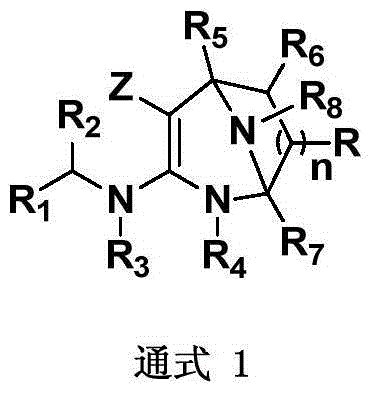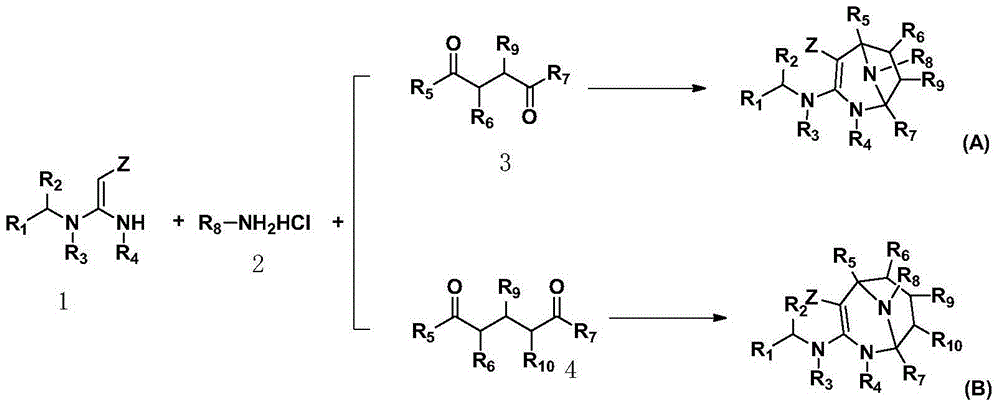Nitrogen-containing bridged ring compound having insect disinfestation activity, preparation and uses thereof
A compound and unsaturated technology, applied in the field of nitrogen-containing bridged ring neonicotinoid insecticides, can solve the problems of narrow insecticidal spectrum and limited drug selectivity, and achieve expanded insecticidal spectrum, significant insecticidal activity, and The effect of broad spectrum
- Summary
- Abstract
- Description
- Claims
- Application Information
AI Technical Summary
Problems solved by technology
Method used
Image
Examples
preparation example Construction
[0109] The preparation method of the compound of the present invention
[0110] The compound of general formula A and B structure of the present invention can be prepared by the following method, but the conditions of the method, such as the amount of reactant, solvent, base, compound used, reaction temperature, reaction time required etc. are not limited to the following explanations. The compound of the present invention can also be conveniently prepared by optionally combining various synthetic methods described in the specification or known in the art. Such a combination can be easily performed by those skilled in the art to which the present invention belongs.
[0111] Protonic acids or Lewis acids used in the reaction include (but are not limited to): hydrochloric acid, acetic acid, sodium dihydrogen phosphate, p-toluenesulfonic acid, trifluoroacetic acid, boron trifluoride, aluminum trichloride, ferric chloride, magnesium chloride , cobalt chloride, strontium chloride...
Embodiment 1-32
[0133] Example 1-32: Preparation of heterobridged ring neonicotinoid compounds
Embodiment 1
[0134] Example 1: 1-((6-chlorophen-3-yl)methyl)-9-nitro-2,3,5,6,7,8-hexahydro-1H-5,8-cycloimine Synthesis of imidazo[1,2-a]azepane:
[0135]
[0136] 1.270g (5.0mmol) of 2-chloro-5-((2-(nitromethylene) imidazolin-1-yl) methyl) benzene and 0.266g (5.0mmol) of ammonium chloride were added to 20ml Acetonitrile, slowly dropwise add 0.430g (5.0mmol) of succinic dialdehyde. After reacting for 24 hours, the solvent was removed, and the pure product was obtained as light yellow powder through column chromatography separation, with a yield of 38%. 1 HNMR (400MHz, DMSO-d 6 )δ8.66(d,J=2.9Hz,1H),8.01(dd,J 1 =8.0Hz,J 2 =2.0Hz,1H),7.30(d,J=14.9Hz,1H),4.81(s,2H),4.28(t,J=7.3Hz,1H),3.96(t,J=8.7Hz,1H), 3.18(t, J=13.9Hz, 1H), 3.05(t, J=13.8Hz, 1H), 2.89(t, J=13.7Hz, 1H), 2.69(t, J=13.9Hz, 1H), 2.27( s,1H),1.95–1.75(m,1H),1.72–1.41(m,2H),1.32–1.11(m,1H)ppm; 13 CNMR (100MHz, DMSO-d 6 ): δ149.48, 148.61, 138.84, 130.35, 123.76, 64.35, 54.68, 50.62, 49.31, 29.97, 27.81ppm; HRMS(ES+)C 14...
PUM
 Login to View More
Login to View More Abstract
Description
Claims
Application Information
 Login to View More
Login to View More - R&D
- Intellectual Property
- Life Sciences
- Materials
- Tech Scout
- Unparalleled Data Quality
- Higher Quality Content
- 60% Fewer Hallucinations
Browse by: Latest US Patents, China's latest patents, Technical Efficacy Thesaurus, Application Domain, Technology Topic, Popular Technical Reports.
© 2025 PatSnap. All rights reserved.Legal|Privacy policy|Modern Slavery Act Transparency Statement|Sitemap|About US| Contact US: help@patsnap.com



